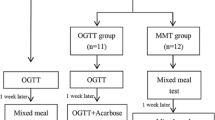Abstract
Objective
To observe the therapeutic effect of Tang No.1 granule (糖1号方, T1G) in treating patients with impaired glucose tolerance (IGT). Methods: One hundred and forty patients with IGT and with Pi (脾)-Wei (胃) dampness-heat syndrome type were assigned randomly according to their visiting sequence into two equal groups. The control group received only general knowledge about IGT, but to the treated group, based on current knowledge available, T1G was given additionally for 6 months. Changes in related laboratory indexes, including fasting plasma glucose and insulin (FPG and FINS), plasma glucose 2 h after meal (2hPG), glycosylated hemoglobin (HbA1c), serum triglyceride (TG), low density lipoprotein cholesterol (LDL) and insulin resistance index (HOMA-IR), were observed. Results: The levels of FPG, 2hPG, HbA1c, FINS, TG and HOMA-IR were significantly decreased after treatment in the treated group, showing a significant difference compared to the control group (P<0.01). Among them, HbA1c decreased from 7.08±1.41% to 6.56±1.29% in the treated group, while in the control group, it decreased from 7.02±1.37% to 6.93±1.31%. The level of LDL was also reduced in the treated group after treatment (P<0.05). In the treated group, 13 out of 68 patients (19.12%) had their glucose tolerance reversed to normal, while in the control group, only 2/64 (3.1%) got it reverse; a comparison between the two groups in terms of reversion rate showed a significant difference (P<0.01). No severe adverse reaction was found in the therapeutic course.
Conclusions
T1G has good clinical effect as a treatment intervention for IGT, as it could improve glycometabolism, significantly depress the levels of post-prandial blood sugar and blood lipids, alleviate clinical symptoms of patients, and effectively cut-off and reverse the yielding and development of diabetes mellitus.
Similar content being viewed by others

References
Mitrakou A, Kelley D, Mokan M, et al. Role of reduced suppression of glucose production and diminished early insulin release in impaired glucose tolerance. N Engl J Med 1992;326:22–29.
Shaw JE, Zimmet PZ, De Courten M, et al. Impaired fasting glucose or impaired glucose tolerance. What best predicts future diabetes in Mauritius? Diabetes Care 1999;22:399–402.
Sicree R, Shaw JE, Zimmet PZ. The global burden of diabetes. In: Gan D, ed. Diabetes atlas. 2nd ed. Brussels: International Diabetes Federation, 2003:15–17.
Liao EY, Chao CS. Endocrinology. Beijing: People’s Medical Publishing Housing, 2001:1411–1418.
Zheng XY. Guiding principle of clinical research on new drugs of TCM. Beijing: China Medic-Pharmaceutical Sciences and Technology Publishing House, 2002: 233–237.
Chinasson JL, Josse RG, Gomis R, et al. Acarbose treatment and the risk of cardiovascular disease and hypertension in patients with impaired glucose tolerance: the STOP-NIDDM trial. JAMA 2003;290:486–494.
Ratner R, Goldberg R, Haffner S, et al. Impact of intensive lifestyle and metformin therapy on cardiovascuar disease risk factors in the diabetes prevention program. Diabetes Care 2005;28:888–894.
Richter B, Bandeira-Echtler E, Bergerhoff K, et al. Rosiglitazone for type 2 diabetes mellitus. Cochrane Database Syst Rev 2007;18;(3):CD006063.
Pan XR, Li GW, Hu YH, et al. Effect of dietary and/or exercise intervention on incidence of diabetes in 530 subjects with impaired glucose tolerance from 1986–1992. Chin J Intern Med (Chin) 1995;34(2):108–112.
Yang WY, Lin LX, Qi JW, et al. The preventive effect of Acarbose and Metformin on the IGT population from becoming diabetes mellitus: a 3-year multicentral prospective study. Chin J Endocrinol Metab (Chin) 2001;17(3):7–10.
Shen YJ, Li YK. Pharmacology of Chinese materia medica. Shanghai: Shanghai Scientific and Technical Publishers, 1997:161,165.
Qian QH, Li YZ, Huang DH, et al. Effects of Sanhuang Xiaoke Capsule on insulin in rat model with type 2 diabetes resistance. J Shandong Univ Tradit Chin Med (Chin) 2005;29(5):392–394.
Zou WJ, Bai HY, Gao XP. The influence of P thomsonii Benth on insulin resistance induced by Dexamethasone. Chin Pharmacol Bull (Cjin) 2004;20(6):715–716.
Cheng YC, Qian QH, Mao C, et al. A clinical and experimental research on treating by replenishing qi and strengthening the spleen. J Shandong Univ Tradit Chin Med (Chin) 1994;18(1):21.
Author information
Authors and Affiliations
Corresponding author
Rights and permissions
About this article
Cite this article
Wei, Y., Hong, Yz. & Ye, X. Effect of Tang No.1 granule (糖1号方) in treating patients with impaired glucose tolerance. Chin. J. Integr. Med. 14, 298–302 (2008). https://doi.org/10.1007/s11655-008-0298-7
Received:
Published:
Issue Date:
DOI: https://doi.org/10.1007/s11655-008-0298-7



